Figs. 33.1, 33.2, and 33.3
Areas of application of intravenous regional anesthesia
Specific Contraindications
Patient refusal
Local infection in the area to be anesthetized
Local nerve damage
Peripheral vascular diseases
Severe decompensated hypovolemia, shock
Certain cardiovascular diseases
Hypertonia, bradycardia, second-degree AV block, any history of a tendency to syncope
Musculoskeletal diseases
Procedure
This block should only be carried out when full anesthetic facilities are available. Full prior information for the patient is mandatory.
Preparations
Check that the appropriate emergency equipment is present and in working order. Sterile precautions. Two intravenous access points (in the healthy extremity as well as the one being operated on), BP and ECG monitoring, pulse oximetry, anesthesia machine. Patient preparation is the same as for general anesthesia.
Materials (Fig. 33.4)
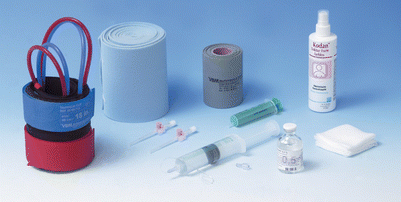
Fig. 33.4
Materials
A 20- and 50-mL syringes, saline, cotton-wool padding, pneumatic tourniquet (double-lumen), Esmarch bandage, local anesthetic, disinfectant, pneumatic tourniquet device (e.g., VBM Medizintechnik Ltd., Sulz am Neckar, Germany; Fig. 33.5).
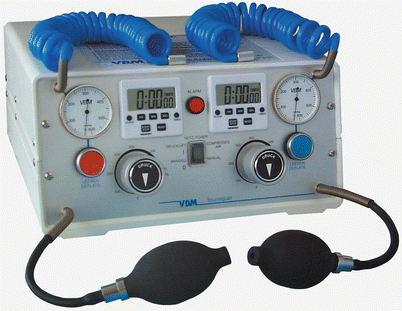

Fig. 33.5
Pneumatic tourniquet device (VBM Medizintechnik Ltd., Sulz am Neckar, Germany)
Patient Positioning
Supine, with the extremity free.
Technical Procedure
1.
Insert two intravenous catheters—one in a healthy extremity and the other as distally as possible in the extremity being operated on.
2.
Place the extremity being operated on in a free position and put soft padding under the tourniquet to help prevent nerve injury (Fig. 33.6).
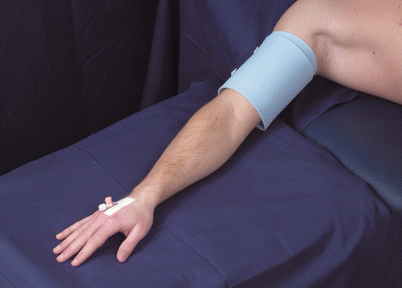

Fig. 33.6
Padding of the tourniquet area, intravenous access
3.
Position the double-lumen tourniquet.
4.
Elevate and massage the limb for a few minutes and then wrap it completely with an Esmarch bandage (Fig. 33.7).
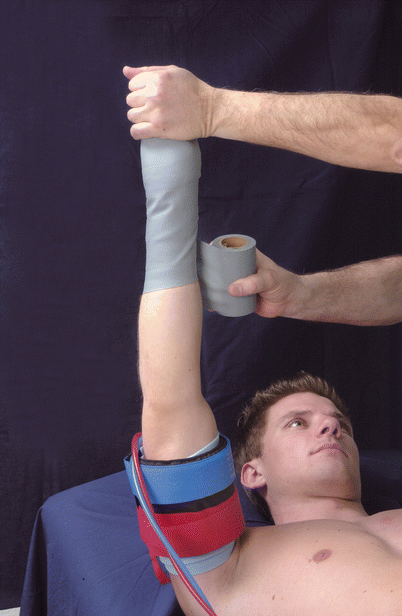

Fig. 33.7
Wrapping with an Esmarch bandage
5.
Inflate the proximal cuff: the pressure in the cuff has to be ca. 80–100 mmHg higher than the patient’s systolic blood pressure. The pressure that should be used depends on the thickness of the muscles being compressed. A pulse oximeter is used to document changes in, and cessation of, the pulse (“pulse occlusion pressure”) and the disappearance of the pulse in the radial artery. The “pulse occlusion pressure” can be used to determine the optimal pressure in the proximal cuff (Fig. 33.8).


Fig. 33.8
Inflation of the tourniquet
6.
Remove the bandage and place the extremity in a horizontal position.
7.
Get Clinical Tree app for offline access

Slowly inject the local anesthetic (20 mL/min; Fig. 33.9).
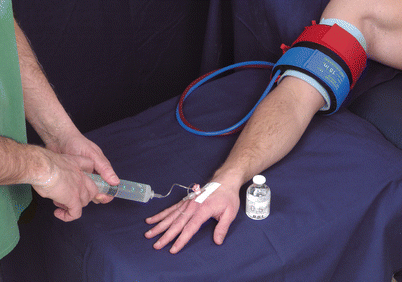

Fig. 33.9




Injection of the local anesthetic
Stay updated, free articles. Join our Telegram channel

Full access? Get Clinical Tree








